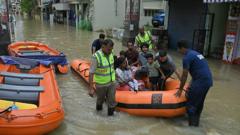As Armenia aims to establish itself as a tech powerhouse, initiatives like the Armath program are cultivating a generation of young engineers. Leveraging its rich history in mathematics and recent influxes of international tech talent, Armenia is set on a path toward becoming a notable player in the global tech landscape.
Armenia's Ambition: Cultivating a Tech Haven in the Caucasus

Armenia's Ambition: Cultivating a Tech Haven in the Caucasus
Armenia is on a mission to transform into a thriving technology hub, nurturing young innovators and attracting global talent.
In the heart of Yerevan, young innovators like nine-year-old Slavik are already showcasing their technological prowess, designing projects ranging from smart greenhouses to automated household devices. This vibrant scene unfolds in state-run schools where the Armath program, initiated in 2014, has established over 650 labs to provide tech education across Armenia. Supported by the Union of Advanced Technology Enterprises (UATE), the initiative aims to illuminate the path for 5,000 aspiring engineers each year, ultimately transforming Armenia into a technological hub.
CEO of UATE, Sarkis Karapetyan, underscores their commitment: "We want Armenia to be a tech center powerhouse that delivers utmost values." With around 4,000 tech firms currently operating in Armenia, the seeds of this vision are already blooming. Historically significant in mathematics and computing, Armenia continues to build on its legacy with notable success stories such as Picsart and Krisp, establishing its standing in the competitive tech landscape.
Despite its landlocked geography and historical border disputes, Armenia has earned the title of the best country in the Caucasus for launching a startup, ranking 57th globally. The nation is also blessed with a vast diaspora, which facilitates vital connections, especially within the U.S. tech sector. Samvel Khachikyan from SmartGate discusses how they aid Armenian entrepreneurs in navigating the American market, drawing on personal ties and mentorship.
Armenia’s tech ecosystem was further bolstered by the influx of Russian IT professionals seeking refuge after the conflict in Ukraine, with reports suggesting that between 5,000 to 8,000 have settled there since. This convergence has filled essential skill gaps in cybersecurity and data processing, propelling the industry forward. However, challenges remain, including high living costs and concerns about tax burdens on tech firms.
Amid these challenges, optimism prevails as the potential for growth in Armenia's tech sector is substantial. With companies such as Service Titan achieving valuations over $10 billion, the future of this budding tech landscape appears promising. As the country continues its quest to realize its Silicon Valley aspirations, the world is watching closely, eager to witness the transformation of this small nation into a major technology player in the region.


















